Odissi Style
Odissi, the classic dance from state Orissa developed in the temple atmosphere.
This is a lyrical dance style; it has rules of body motions completely different
from other dance forms. Its main quality is elegance; its aesthetics is built on
close connection of poetry and music.
The state of Orissa can fully be proud of having experienced numerous cultural
influences. In different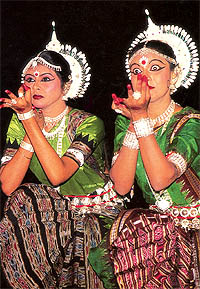 periods of its history representatives of various races
and beliefs conquered this land and contributed to the blending of ideas,
notions and religions. The location of state on the eastern coast of the central
India was the reason for the waves of cultural and historical influence which in
their turn caused the appearance of a completely unique philosophy of Jagannath.
Like in other regions of India, religious philosophy determined the development
of arts; the dance initially took refuge in the cult complex. Even today all
celebrations in Orissa cannot do without dance and music. periods of its history representatives of various races
and beliefs conquered this land and contributed to the blending of ideas,
notions and religions. The location of state on the eastern coast of the central
India was the reason for the waves of cultural and historical influence which in
their turn caused the appearance of a completely unique philosophy of Jagannath.
Like in other regions of India, religious philosophy determined the development
of arts; the dance initially took refuge in the cult complex. Even today all
celebrations in Orissa cannot do without dance and music.
The temples of Orissa dedicated to Shiva store numerous complexes in tracery and
wonderfully manufactured carved panels which contents are indicative of the
strong wave of shivaism that overflowed Orissa in times of Shankaracharya’s
mission. Facades of many monuments of this period are decorated with images of
Nataraja and other incarnations of Shiva and his son Ganesha. In Mukteshvar
temple you can see Shiva’s image in the tandava position. There also occur
images of musicians but not in static poses: you feel rhythm and joy in their
motions. These images are connected with the plasticity of modern Odissi by
perceptible threads.
Kings who ruled Orissa in the period between VIII and XI centuries were called
gandharva Kesari and
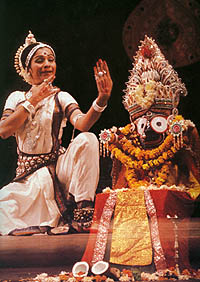 nritya Kesari. They quite obviously considered it a matter
of honor to reach the heights in the arts of dance and music. It is in this
period that the writings about devadasis or women dedicated to serve a deity
were carved in Bhubaneshvar temple. Apparently devadasis played an important
role in a temple ritual. During bhog they were to dance since the first twilight
till god Jagannath, the Puri temple deity, went to bed. nritya Kesari. They quite obviously considered it a matter
of honor to reach the heights in the arts of dance and music. It is in this
period that the writings about devadasis or women dedicated to serve a deity
were carved in Bhubaneshvar temple. Apparently devadasis played an important
role in a temple ritual. During bhog they were to dance since the first twilight
till god Jagannath, the Puri temple deity, went to bed.
Jagannath’s temple in Puri, Odissi’s stronghold, was built by the kings of Gang
dynasty who ruled for more than four centuries and acted as mighty patrons of
art, architecture and religion. By that time the Vishnuist philosophic system of
Ramanudji had spread all around the country. Nevertheless, the shivaist
ceremonies were not forgotten.
Jagannatha’s dharma absorbs all the differences. It is believed to be a mixture
of more than fifteen religious and cultural trends. Perhaps it was Chodaganga
himself who built Jagannath’s temple and invited maharis, experienced dancers,
to perform in the temple. He is famous in Orissi for his passion for fine arts.
It is important to know that Nataraja and the dancing Ganesha neighbor with the
numerous images narrating about Krishna’s life. This acknowledges the point of
view that the cult of Jagannath admitted such synthesis of vishnuit and shivaist
traditions.
In the wonderful Temple of the Sun in Konarak built in XIII century with its
Nata Mandapa or the Dance Hall, probably the most complex in implementation in
all India series of sculptures picturing dance is preserved. This is the place
of pilgrimage for all dancers and art lovers. Apparently the Hall was used for
dancing performances in gods’ honor; the temple in Konarak is believed to have
invited a great number of dancers. The whole temple complex is built in the
shape of the sun god’s chariot harnessed with seven wonderful horses. Sculptures
dedicated to dance are especially numerous in Nata Mandapa; its proximity to the
sea emphasizes the unearthly beauty of the Dance Hall. preserved. This is the place
of pilgrimage for all dancers and art lovers. Apparently the Hall was used for
dancing performances in gods’ honor; the temple in Konarak is believed to have
invited a great number of dancers. The whole temple complex is built in the
shape of the sun god’s chariot harnessed with seven wonderful horses. Sculptures
dedicated to dance are especially numerous in Nata Mandapa; its proximity to the
sea emphasizes the unearthly beauty of the Dance Hall.
In about XV century in the reign of the Surya dynasty, abhinaya or dramatically
expressive dance appeared in Orissa. It was then that Orissa reached the top of
glory in the fields of art and literature. Ray Ramamand a minister at the court
of Prataparudradeva was himself busy in training devadasis. He saw that dances
based on "Gita-Govinda" be performed carefully and emotionally.
In XV century Maheshvar Mohapatra being at court of Narayanadeva wrote his book
"Abhinaya Chandrika". This laborious research paper of Odissi even today is
considered necessary for studying this dance style.
By XVI century there had been three types of dancers in Orissi: maharis in
temples, nachuni at royal
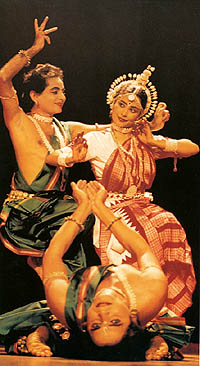 court and gotipuas in akhadas (halls) who performed
before public. Only maharis were admitted to the inner sacred chambers of a
temple. Their tradition was strictly observed, there existed tough rules of
behavior and etiquette for them. They entered a simple marriage with a "deity"
and thus their service to it began. Their ritual dances were performed in the
atmosphere of a lofty devotion. However, later lust of the ruling circles and
British powers led to degeneration of this kind of art, its religious elements
lost their meaning, it turned into a mere means of entertainment for the royal
court. Many temples were completely abandoned. court and gotipuas in akhadas (halls) who performed
before public. Only maharis were admitted to the inner sacred chambers of a
temple. Their tradition was strictly observed, there existed tough rules of
behavior and etiquette for them. They entered a simple marriage with a "deity"
and thus their service to it began. Their ritual dances were performed in the
atmosphere of a lofty devotion. However, later lust of the ruling circles and
British powers led to degeneration of this kind of art, its religious elements
lost their meaning, it turned into a mere means of entertainment for the royal
court. Many temples were completely abandoned.
In the period of religious revival in XVII century temples again started to be
patrons of art. But maharis were gradually disappearing; they were replaced by
gotipuas, boys dressed as girls with the necessary physical training in akhadas.
They performed Bandha Nritya consisted of complex statuesque poses and bows.
Rich landlords favored gotipua companies who traveled across the state in groups
and entertained the public. Their virtuosity was based on the flexibility of
their almost gymnastic style. However, later the simplicity of their dance was
stained by the wave of vulgarization that touched both their costumes and stage
manner. As soon as they started making compromise their social status reduced
and gradually they became a tribe of dying out artists. But for justice' sake it
should be noted that they had always been good singers and dancers and in spite
of social and political storms of the XVII century when stagnation reigned in
all fields of art, it was gotipuas who saved the basis for the future revival of
the ancient tradition.
By the beginning of the ХVII century the mahari tradition had significantly
weakened and had completely disappeared by the 1940s of the last century.
Nachunis disappeared in the XIX century. Only gotipuas left and it was their
reconstituted repertoire that became the background for the new style. The
followers of the revival considered the refined variant of gotipua’s repertoire,
"Abhinaya Chandrika" and numerous poses of dancers in Odissi temples as a
yardstick to authenticity.
It is better not to compare styles of Indian classic dance with each other. Each
has its own charm and beauty. They have different techniques, different history,
different manner of plot presenting, different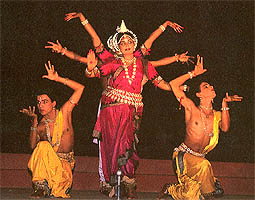 emotional colors, they influence
views in different ways, but in spite of all that some scientists and writers
can’t wait to start comparing them. Its own unusual charm, the harmony of
movement lines are inherent with Odissi, it is a very "sculptural" dance style. emotional colors, they influence
views in different ways, but in spite of all that some scientists and writers
can’t wait to start comparing them. Its own unusual charm, the harmony of
movement lines are inherent with Odissi, it is a very "sculptural" dance style.
The Odissi technique is based on chouka, a position when hands and legs are bent
at right angles, with elbows and knees moved apart. It is a male position by its
character; the body weight is distributed equally between both legs. You can see
the same pose in the image of Jagannath in Puri temple; perhaps it reflects the
balanced, overwhelming and universal nature of god Jagannath’s dharma. This is
samabhanga or a balanced position.
The second important position is abhanga when the body weight is shifted on one
leg, the other leg is bent in a knee in a standing or semi-sitting position.
The next position is tribhanga when a body is bent three times in such a way
that lines of arms and
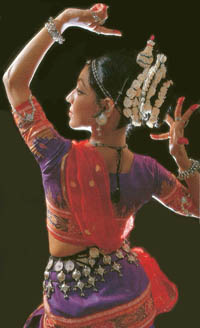 legs form triangles. The body line is broken in knees,
waist and neck. Hands, ankles and legs form triangles of different sizes. This
is the most interesting pose in Odissi. This is the unbalanced figure which is
not only hard to achieve but also requires of a dancer to have great
self-restrain and self-control if she wants to execute it in a beautiful and
nice way. There is something airy about it and unlike chouka it is very feminine.
When tribhanga is performed without proper attention it produces a terrible
impression for it emphasizes the forms of a female body exaggeratedly up to the
extent of ugliness. Tribhanga is represented in sculptural portrayals of female
figures and like sculpture is based on Hinduism conception of iconography. Music
in Odissi is very lyrical, tribhanga as if naturally flows into its mood or
melodic pattern. In most other dance styles the shifting of body weight from one
leg upon another is forbidden, but this triple bends are the very essence of the
style. legs form triangles. The body line is broken in knees,
waist and neck. Hands, ankles and legs form triangles of different sizes. This
is the most interesting pose in Odissi. This is the unbalanced figure which is
not only hard to achieve but also requires of a dancer to have great
self-restrain and self-control if she wants to execute it in a beautiful and
nice way. There is something airy about it and unlike chouka it is very feminine.
When tribhanga is performed without proper attention it produces a terrible
impression for it emphasizes the forms of a female body exaggeratedly up to the
extent of ugliness. Tribhanga is represented in sculptural portrayals of female
figures and like sculpture is based on Hinduism conception of iconography. Music
in Odissi is very lyrical, tribhanga as if naturally flows into its mood or
melodic pattern. In most other dance styles the shifting of body weight from one
leg upon another is forbidden, but this triple bends are the very essence of the
style.
Then come padabhedas or the leg positions: sama, kumbha, dhanu, maha, eka,
lolita, nupura, suchi, ashrita, trasya and rekha. Combinations of body and legs
positions give birth to a variety of basic positions exceeding the ordinary
supply of other styles. What is unusual about legs position is that a dancer
sometimes touches the floor with only a heel or a toe. Chali or gait is the way
of movement on stage. Every chali is pretty complex; they differ in speed of
performance and meaning. The dance portrays numerous variants of a female gait;
it is compared with the gait of different animals more often with that of a swan,
a peacock, a deer and an elephant.
Bhumi, the way of movement on stage is closely connected with padabheda or legs
positions, and bhangi - body poses that were mentioned above. Bhumi is also a
part of the stage around a dancer. Legs move in a certain way and draw a circle,
a square or a semicircle. Legs step forth out of the central point and asides so
that the drawn circle becomes larger. There was an opinion that drawing circles
and squares in a dancer’s movements goes back to Tantric cults that were once
strong in Orissa. A circle and a square have a great meaning in Tantra. However,
future dancers studying Odissi do not meditate on the bhumi meaning aiming only
at learning the movements and often do not suspect of the possible explanation.
In Odissi legs also have several unusual movements. First of all there are
certain points on the floor around the dancer where he/she puts his/her foot on.
Legs move sideways, the knees are moved far apart. Before placing a foot on the
floor a dancer often raises it a little with a toe pulled down or raises it up
high without bending. A circular movement is possible when a foot is put on the
floor from one side and the body follows it in the same wavy way. This is an
especially thrilling moment in dance. A dancer often puts a leg forth then
raises it and carries it backwards in a spiral movement. A dancer sometimes
switches to heels with toes raised and goes backwards in this position while
making circular movements with arms.
Brahmaris are turns or circular movements around a vertical axis. Ekapada
brahmari is a special figure when a dancer makes a full turn on one leg in
chouka or tribhanga positions with a foot of one leg raised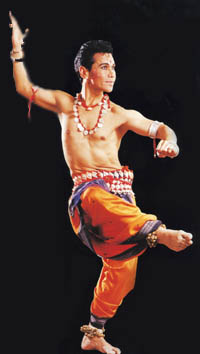 to the knee level of
the other leg, in the front or in the back. This turn is performed clockwise or
counterclockwise. to the knee level of
the other leg, in the front or in the back. This turn is performed clockwise or
counterclockwise.
The peculiarity of Odissi is in the direct correspondence of body movements with
the positions and movements of the lower parts of body. Legs hold the moving
body firmly, hips are motionless. The upper part of the body makes soft wavy
movements in a vertical position; the head is inclined to the side opposite to
the body all the time thus producing a very beautiful, lyrical and spectacular
effect. The meaning of this movement in Odissi is often underestimated, a very
reserved movement of the upper part of body, especially its back turns into the
movement of hips that is highly unaesthetic though easier to perform. It is this
body movement that gives Odissi its special nuance. It is only in brahmari or
during turns that the body moves horizontally.
In nritya or Odissi plot dance, hastas render songs’ meaning and decorate
fragments of pure dance. In every classic dance especially in Kathakali, Bharata
Natyam and Odissi the hastas described in "Abhinaya Darpana" are widely spread.
However, dancers of each style and especially in Kathakali and Odissi also stick
to their own apocryphal texts and an Odissi dancer follows "Abhinaya Chandrika"
by Maheshvar Mohapatra.
In Odissi they use several hastas described in "Abhinaya Chandrika", and the
hastas completely different from those that occur in Bharata Natyam or Kathakali.
These hastas still exist today and are passed down orally from generation to
generation.
Natya or the dramatic element of the dance existed in Orissa in the times when
gotipuas played in
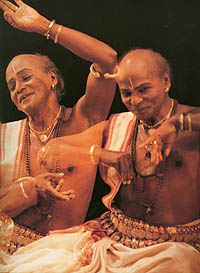 jatra troupes. These troupes were supported by a local
zemindar or a landlord. Their programmes were more like dramatized performances
with dances where the plot was played by several dancers. Tradition of these
dance dramas developed unevenly. Within last thirty years the most interest is
shown in solo performances on stage. However, some gurus who had a lot of
shishyas or pupils nevertheless found the way to preserve the tradition. Among
them Guru Kelucharan Mohapatra should be noted who acted as choreographer of
some numbers and also dance dramas "Kanchi Vidjai", "Gita Govinda", "Kishor
Chandrananda Champu" and "Konarak Vidjai" where he used the classic technique,
the respective orchestral accompaniment, several personages, costumes and change
of decorations. jatra troupes. These troupes were supported by a local
zemindar or a landlord. Their programmes were more like dramatized performances
with dances where the plot was played by several dancers. Tradition of these
dance dramas developed unevenly. Within last thirty years the most interest is
shown in solo performances on stage. However, some gurus who had a lot of
shishyas or pupils nevertheless found the way to preserve the tradition. Among
them Guru Kelucharan Mohapatra should be noted who acted as choreographer of
some numbers and also dance dramas "Kanchi Vidjai", "Gita Govinda", "Kishor
Chandrananda Champu" and "Konarak Vidjai" where he used the classic technique,
the respective orchestral accompaniment, several personages, costumes and change
of decorations.
An Odissi dancer’s costume is a practical silk sari. Perhaps maharis used to
wear it in a slightly different way, one cannot exclude that their clothes were
decorated with multicoloured stones, but nowadays dancers have refused all this.
Only the dancers who guard the tradition make very little changes in costume.
Ornaments are made of silver, though perhaps gold was used with the same purpose.
A dancer’s head is decorated with mathamani, ears with kapas, wrists with
bahichudi or tayita, there is a belt of fine work on her waist; small bells
strung on one small strap are ringing on her ankles; on her neck there is a
padaka-tilaka a necklace with a locket.
Besides, Odissi dancers erect themselves a quite complex hair bun decorated with
tahiya, a miniature portrayal of temple gopura (tower); garlands of flowers are
entwined into hair. Besides a standard make-up that performers of classic dance
use, an Odissi dancer applies gorachan on her brows, a line that is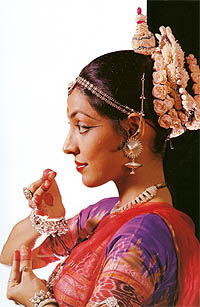 drawn along
a brow down to a cheek-bone with chandan (sandal paste). And finally, red liquid
alta is sprayed on palms and feet. drawn along
a brow down to a cheek-bone with chandan (sandal paste). And finally, red liquid
alta is sprayed on palms and feet.
Nowadays an Odissi dancer is usually accompanied by a musician playing mardala
or pakhawaj, a flutist and a singer. Mardala is a traditional drum played by a
guru who beats bolas and pronounces drum syllable formulae out loud accompanying
to the fragments of the pure dance. Manjiras or small brass cymbals used to keep
the subtle nuances of the rhythmic accompaniment are also used effectively.
According to tradition maharis used to sing by themselves, but as a result of
the dance moving on stage and into big halls this mission was taken upon by a
professional singer. Nowadays an Odissi dancer is sometimes accompanied by a
sitarist instead of a more customary in the past violinist, who appeared as a
result of the influence of the neighbouring Karnatak. However, more often among
all instrumentalists a flutist is invited.
The dance is the expression of a person’s joy by means of movement. When this
pure expression and the liberated freedom are enclosed into classic frames, they
must firmly stick to certain technical rules. The richest means of this
technique lie at the basis of Odissi, there are a lot of rules written in texts
or passed down orally. Legs positions, foot standing on a heel or a toe, the
body position, the body bending, the plasticity of movement and the gait all
together form a splendid sight. These are very stylized, subtle and elegant
movements making an impression that a dancer constantly makes poses to bring joy
to eyes and cause aesthetic pleasure.
Based on the book "Rhythm In Joy" by Leela Samson
| 